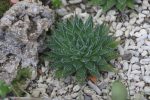 Aloes are succulents in the Asphodelaceae family that also includes daylily (Hemerocallis), red hot poker (Kniphofia), and foxtail lily (Eremurus) The genus includes over 500 species in that are native to tropical and southern Africa, Madagascar, Jordan, the Arabian Peninsula, and islands in the Indian Ocean. Although aloes may be trees, shrubs, or vines, the short stemmed or stemless perennials are the only ones that are grown ornamentally. They usually form a rosette of evergreen, fleshy, tapering, sharp pointed leaves that have marginal teeth or spines. The tubular flowers are yellow, orange, pink, or red and carried well above the foliage in dense clusters on leafless branched or unbranched stems. Plants like fertile, well-drained , slightly alkaline soil and full sun, but tolerate lean soil, some shade, drought and salt. They are suitable for borders and containers as well as succulent, rock, and coastal gardens. Propagation is by seed, division of offsets, and leaf cuttings. The genus name, Aloe, is derived from the Arabic word alloeh meaning bitter and shiny substance and refers to the latex in the leaves .
Aloes are succulents in the Asphodelaceae family that also includes daylily (Hemerocallis), red hot poker (Kniphofia), and foxtail lily (Eremurus) The genus includes over 500 species in that are native to tropical and southern Africa, Madagascar, Jordan, the Arabian Peninsula, and islands in the Indian Ocean. Although aloes may be trees, shrubs, or vines, the short stemmed or stemless perennials are the only ones that are grown ornamentally. They usually form a rosette of evergreen, fleshy, tapering, sharp pointed leaves that have marginal teeth or spines. The tubular flowers are yellow, orange, pink, or red and carried well above the foliage in dense clusters on leafless branched or unbranched stems. Plants like fertile, well-drained , slightly alkaline soil and full sun, but tolerate lean soil, some shade, drought and salt. They are suitable for borders and containers as well as succulent, rock, and coastal gardens. Propagation is by seed, division of offsets, and leaf cuttings. The genus name, Aloe, is derived from the Arabic word alloeh meaning bitter and shiny substance and refers to the latex in the leaves .
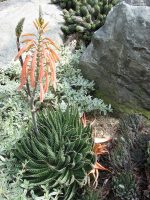 Lace Aloe (A. aristata)
Lace Aloe (A. aristata)
Native to South Africa and Lesotho,lace aloe is also called torch plant. It consist of a rosette of crowded stemless leaves that are 4″ long, lanceolate, and adorned with white spots, white teeth on the margins, and an apical tuft of hairs with a soft white spine. From late spring to summer 20″ long stems produce conical branched clusters of tubular flowers that are 1.25″ long and orange red. Plants readily produce off set and form attractive clumps. Lace aloe is a good choice for borders, rock gardens, succulent gardens, and containers.
Height:1-1.5′
Bloom Time: Late spring to summer
Hardiness: Zones 9-10
Aloe vera (A. barbadensis)
The origin of aloe vera is uncertain and it may be native to the Canary Islands, Madeira, and the Cape Verde Islands or the Arabian Peninsula. Plants grow 8-36″ high and form a stemless rosette of glaucous gray green, lanceolate leaves that are 1-2′ long and have white to reddish teeth. The yellow to orange-red flowers are 1-2″ long and appear on slender branched stems 2-3′ long from late spring to early summer. The leaves contain a mucilaginous sap that can be used to treat burns including sunburn and is often included in body lotions and creams for its restorative and medicinal properties.
Height: 8-36″
Bloom Time: Late spring to early summer
Hardiness: Zones 9-11
Soap Aloe (A. maculata aka A saponaria)
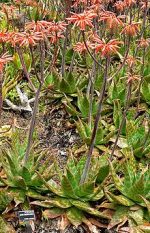 Also known as zebra aloe, soap aloe is native to southern and eastern South Africa, and south-eastern Botswana and Zimbabwe where it grows in a variety of habitats from rocky outcrops to thickets and grasslands. Plants form small rosettes of broad, fleshy, sword shaped leaves that are mostly recurved towards the dried, twisted tips. The leaves vary in color from red to green but always have H shaped white markings and sharp teeth on the margins. Branched stalks up to 3′ tall carry yellow to red flowers in a flat-topped raceme. The flowers appear from late winter to spring and intermittently thereafter, and are attractive to bees and hummingbirds.
Also known as zebra aloe, soap aloe is native to southern and eastern South Africa, and south-eastern Botswana and Zimbabwe where it grows in a variety of habitats from rocky outcrops to thickets and grasslands. Plants form small rosettes of broad, fleshy, sword shaped leaves that are mostly recurved towards the dried, twisted tips. The leaves vary in color from red to green but always have H shaped white markings and sharp teeth on the margins. Branched stalks up to 3′ tall carry yellow to red flowers in a flat-topped raceme. The flowers appear from late winter to spring and intermittently thereafter, and are attractive to bees and hummingbirds.
Height: 1-2′
Bloom Time: Late winter to spring; intermittently thereafter
Hardiness: Zones 8-10
Coral Aloe (A. striata)
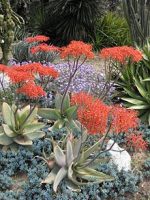 Native to the rocky slopes of coastal and karoo areas of South Africa, coral aloe forms coarse rosettes of broadly ovate leaves that are toothless, 1.5′ long, narrowly striated and edged in red. The gray green leaves tend to take on a pinkish color in full sun while being blue green in more shade. The short decumbent stem elongates to 3″ with maturity. From late winter to early spring 1-3 widely branched flowering stems 2′ arise 2′ above the foliage bearing clusters of coral red flowers 1.25″ long. Many of the plants sold as A. striata are actually a hybrid with A. maculata and have teeth on the leaf margins and lack the rose-tinge on the sun grown leaves.
Native to the rocky slopes of coastal and karoo areas of South Africa, coral aloe forms coarse rosettes of broadly ovate leaves that are toothless, 1.5′ long, narrowly striated and edged in red. The gray green leaves tend to take on a pinkish color in full sun while being blue green in more shade. The short decumbent stem elongates to 3″ with maturity. From late winter to early spring 1-3 widely branched flowering stems 2′ arise 2′ above the foliage bearing clusters of coral red flowers 1.25″ long. Many of the plants sold as A. striata are actually a hybrid with A. maculata and have teeth on the leaf margins and lack the rose-tinge on the sun grown leaves.
Height: 3′
Bloom Time: Late winter to early spring
Hardiness: Zones 9-10
Partridge-Breast (A. variegata aka Gonialoe variegata)
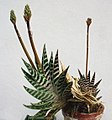 Also known as tiger aloe this species is indigenous to arid and semi-arid regions of South Africa and Namibia where it grows in hard ground, in rocky crevices, and in between rocks as well as in some sandy soils. Plants grow up to 1′ tall and wide and form stemless rosettes of 18-24 triangular-lanceolate leaves that are 4-6″ long and 3-ranked. The leaves have small white teeth on their white horney margins and are dark green variegated by whitish spots that form irregular bands. They may take on a reddish color when water is lacking. In winter short, stout, mostly branched stems give rise to pendent flowers that are up to 18″ long and are usually orange with green edges but may be red or rarely yellow. Plants are especially drought resistant and a good choice for difficult areas where moisture is lacking.
Also known as tiger aloe this species is indigenous to arid and semi-arid regions of South Africa and Namibia where it grows in hard ground, in rocky crevices, and in between rocks as well as in some sandy soils. Plants grow up to 1′ tall and wide and form stemless rosettes of 18-24 triangular-lanceolate leaves that are 4-6″ long and 3-ranked. The leaves have small white teeth on their white horney margins and are dark green variegated by whitish spots that form irregular bands. They may take on a reddish color when water is lacking. In winter short, stout, mostly branched stems give rise to pendent flowers that are up to 18″ long and are usually orange with green edges but may be red or rarely yellow. Plants are especially drought resistant and a good choice for difficult areas where moisture is lacking.
Height: 1′
Bloom Time: Winter
Hardiness: Zones 9-11
All Photo Credits: Wikipedia